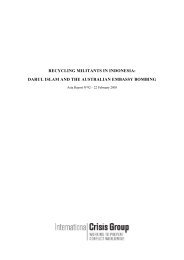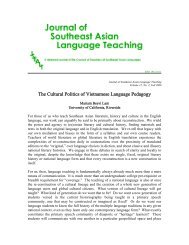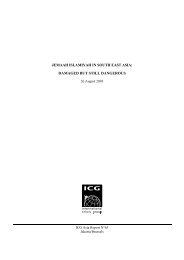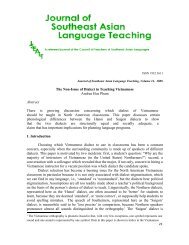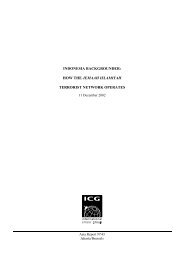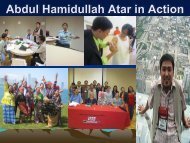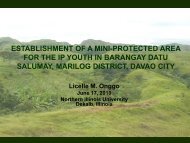Introduction - SEAsite - Northern Illinois University
Introduction - SEAsite - Northern Illinois University
Introduction - SEAsite - Northern Illinois University
You also want an ePaper? Increase the reach of your titles
YUMPU automatically turns print PDFs into web optimized ePapers that Google loves.
Prentation Abstracts<br />
the rich and/or politically well-connected. Barriers to socioeconomic progress that<br />
exist in Laos are numerous. Certain barriers are purely natural phenomena while<br />
others are manmade and event-driven. Lowering these barriers would stimulate<br />
economic growth and social changes, but to whose advantage, the elites or the<br />
mass, it depends on how broadly and far reaching these barriers can be lowered.<br />
However, thus far, the efforts to reduce economic barriers by the Lao government<br />
have focused on natural variables while evidences indicate that governance is the<br />
main impediment to economic and social progress. The absence of fundamental<br />
reforms in governance has caused the fruit of foreign aid and economic growth<br />
to be skewed towards the few urban elites at the expense of the poor. To move<br />
towards sustainability and broad-based economic growth with social advancement<br />
necessary for poverty eradication and beyond, broad-based fundamental changes<br />
are necessary. In this light, this paper examines how and in what key areas has<br />
governance obstructed and promoted socioeconomic progress in Laos.<br />
Vinthany Souvannarath* and Pamela Schaefer** listed but only<br />
Souvannarath<br />
The process of Assimilation: Interview Narratives of six Lao<br />
American Women Refugees<br />
Department of Psychology,<strong>University</strong> of Wisconsin-Milwaukee, Wisconsin<br />
*McNair Scholar<br />
**Professor<br />
After the communist takeover in Laos in 1975, about 16,000 Laotians fled to<br />
the U.S. The Lao currently constitutes less than one percent of the total U.S. population<br />
(Reeves & Bennet, 2003) and have been the least noticed of the groups who<br />
fled from Southeast Asia (Silberman et al., 2001; Cerquone, 1986). In this study I<br />
gathered narrative analyses from six Lao women refugees aged 18-45 from who<br />
have lived in the U.S. for an average of 19 years in a Midwestern state. Semi-structured<br />
interviews were conducted to explore 1) the challenges and adjustments they<br />
had in adapting to the U.S, 2) the extent to which they feel they have integrated in<br />
the U.S. society, and 3) the importance of preserving their cultural identity.<br />
The findings reveal the women’s cultural and linguistic isolation as newcomers<br />
and a range of challenges the women experienced. Challenges of overcoming<br />
traditional behavioral expectations of women, adapting to more individualistic attitudes,<br />
climate and weather change, distaste of American foods, transportation,<br />
and homesickness were reported. The biggest cultural adjustments however, were<br />
acquiring the English language and pursuing education in the U.S. school system.<br />
As hypothesized, the women have not fully integrated in the society and are still<br />
learning to adapt while continuing to maintain their cultural identity.<br />
Kathryn Sweet<br />
Development Opportunities in Rural Laos Project Advisor<br />
Rural Women’s Project, Family Planning Australia, Vientiane, Lao PDR<br />
The paper explores the development landscape in Lao PDR and the effect of<br />
its urban bias on rural communities. It examines the experiences of rural women<br />
in particular, and practical strategies to engage with rural women and improve<br />
their ability to access more development opportunities. Strategies must address<br />
geographical isolation, poor communications links, low levels of formal education<br />
and resulting low fluency in Lao language, poor health, high birth and maternal<br />
mortality rates, and the daily grind of agricultural subsistence. Examples are taken<br />
from the Rural Women’s Project, jointly implemented by Family Planning Australia<br />
and the Lao Women’s Union, in Vientiane province and Xaysomboun Special<br />
Zone.<br />
Bouaphet Sygnavong<br />
The Lost Province of Wapikhamthong (1962-75)<br />
Independent Scholar, California<br />
As a native of Wapikhamthong, I would like to tell the story of my lost home<br />
province which was created in 1962 by a constitutional amendment of the Kingdom<br />
of Laos, but was erased from the map of the world with the advent of the<br />
People’s Democratic Republic at he end of 1975.<br />
The province took its name from two ancient villages established along the<br />
Sedone River in Southern Laos: Wapi, meaning “source,” and Khamtong “gold.”<br />
This golden district was first elevated to the rank of Muong (mandala) in 1713<br />
by King Chao Soi-Sisamouth of Champassack. It kept the same status under the<br />
Siamese occupation, from 1779 to 1893. In the meantime, around 1830-40, Chao<br />
Menh, a son of King Anou, found refuge in Khamtong and married a daughter of<br />
the local ChaoMuong (Governor).<br />
In 1893, when the French took over the left bank of the Mekong River from<br />
Siam, they confirmed Chao Anou’s descendents as administrators of Wapi and<br />
Khamtong districts but incorporated them as part of Saravane Province.<br />
In 1945, when Prince Phetsarath, then Vice-Roy and Prime Minister of the<br />
Kingdom of Luang-Prabang, proclaimed the unification of <strong>Northern</strong> and Southern<br />
Laos as a sole and undivided Lao Kingdom. He chose Phagna Bouakham<br />
Maokhamphiou, one of Chao Anou’s great grandsons, as the first Chaokhoueng<br />
(Governor) of Saravane.<br />
In 1962, the new province of Wapikhamtong was carved out of the boundaries<br />
of its former motherland, Sravane. For a full decade, Wapikhamtong, and<br />
in particular, Khongsedone, the provincial capital, witnessed a fast paced development<br />
with communications improvements, administrative buildings, housings<br />
and new businesses. Unfortunately, this boom was suddenly stopped in 1971 by<br />
the expanding civil war, in the aftermath of Operation Lamson 719. The fate of<br />
Wapikhamthong was finally sealed at the end of 1975 when the new communist<br />
Republic decided to re-incorporate it once more as part of Saravane Province.<br />
Nowadays, Wapikhamtong as a separate provincial entity is gone. There<br />
only remains a few sons and daughters of Wapikhamtong who still stick together<br />
for the worse and the better, in spite of all kinds of adversity. Their former province<br />
may be lost forever, yet, they do not want to forget their special biological or<br />
friendship ties that united them in the past. They try to revive their memory and<br />
their common heritage by organizing family reunions in France and America so<br />
that the younger generations of Wapikhamtong’s children in exile may learn about<br />
their distant Lao roots.<br />
Vinya Sysamouth<br />
Kaan Baan: Sipsongpanna Lue’s Communal Village Activities<br />
in Irrigation<br />
Ph.D. Candidate, <strong>University</strong> of Wisconsin, Madison, Wisconsin<br />
The administrative and political system of Sipsongpanna could be described as<br />
proto Tai feudalism since it is believed to have evolved from the lowest political<br />
system, the baan or village.* The baan serves as a unit of production with certain<br />
autonomy and rights in managing its own affairs. In a Tai Lue village setting,<br />
the division of land, labor, resources, and the burden of responsibilities are based<br />
on egalitarian system (a type of equal field system). In the past men and women<br />
between the ages of 18 and 50 were granted full member status of their respective<br />
baan which entitled them to land allotment and subjected to kaan baan. The<br />
Tai Lue word /kaan 1/ means “work” or “activity” and /baan 1/ means “village.”<br />
Together the words kaan baan mean “village work” or “communal village activities.”<br />
The kaan baan system is used for many activities that deemed beneficial to<br />
the entire community. These activities include road buildings, temple repairs, weir<br />
constructions, and numerous other tasks that are carried out annually or as needed.<br />
The main focus of this presentation will be on how kaan baan is practiced in the<br />
communal irrigation system called nam meuang fai within Xishuangbanna Dai<br />
Autonomous Prefecture’s current political environment. What are the structural<br />
and operational systems of kaan baan? How is kaan baan incorporated into the<br />
regional irrigation management? And what roles and functions will kaan baan play<br />
in the Tai Lue’s lives as a minority group in China?<br />
*Yanyong Chiranakorn and Ratanaporn Sethakul. 2001. Pravatisat Sipsongpanna<br />
(Sipsongpanna History). Sathabun Vithi Dham, Bangkok. (In Thai)<br />
Sary Tatpaporn*, Buasawan Simmala**<br />
US-Laos Trade and Investment: Opportunities and Challenges<br />
*California, USA<br />
**Lao PDR; Wisconsin, USA<br />
Background:<br />
The US and Lao PDR signed the Bilateral Trade Agreement in September<br />
2003. The US Congress passed the NTR legislation to ratify the agreement in<br />
November and the President Bush signed it into law in December 2004.<br />
This historical trade agreement paves the way for both American and Lao<br />
businesses the opportunities to trade and investment between the two countries.<br />
However, the US-Laos trade and investment are very new emerging opportunities






